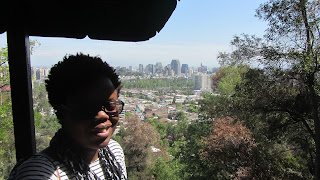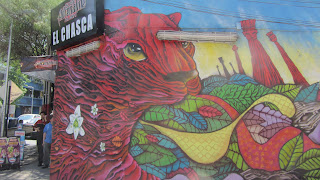[post by Ana]
Our flight from Lima, Peru to Chile was not in any away an eco-route, as much as it was 'purse friendly'. As I mentioned on the entry 'Last weeks in Ecuador', we flew a total of 10 hours Lima-Bolivlia-Chile, in what could have otherwise been a 3 hour flight. Customs and passport control looked funny at us, not understanding the logic in this route, when there are direct flights from Lima to Santiago de Chile. Believe it or not this was, simply said, the 'inexpensive' option.
We arrived late in the night and took a taxi direct to our hotel, the Casa Bonita B&B. En route our cabbie put us up-to-date on the situation in Chile: we arrived in the middle of student strikes demanding a new framework for education in Chile, including more direct state participation in secondary education and an end to the existence of profit in higher education. No new public universities have been built since the end of the Pinochet era, even though the number of university students have swelled. According to the cabbie, these students are just lazy. As it may be, cabbies seem to often have the most graphic and strong opinions about the state of affairs in their country.
We found Santiago de Chile 'expensive', in comparison to its South American sisters. We stayed in Casa Bonita Bed & Breakfast in the Barrio Republica, which is within close proximity to the city center. The owner, Dennis, explained that the building has a high historical value for Chile since it used to belong to the well known Vicaria de la Solidaridad del Arzobispado de Santiago, a foundation created in 1976 aiming to protect and defend human rights during the Military Regime. The Vicaria supported 984 cases and operated during the entire Military Regime. It closed in 1992.
He took on the restoration project and turned into a really nice B&B, it's a beautiful building. We were lodged in the new extended wing.
We stayed in Chile for two days only, literally in transit for our flight to New Zealand.
If I'm going to say anything about Chile, then I have to start with the book I was reading at the time called 'Paula' by Isabel Allende, who is the niece of the late president Salvador Allende. The book itself is about Isabel's daughter but through beautiful writing she manages to offer a passionate depiction of the events that led to the death of Salvador Allende and the mood and unrest at the time. I strongly recommend this reading if you're traveling to Santiago. You get passion, tragedy and the spirit of struggle that seems to be at the heart of many Chileans. So walking down the streets of Santiago we were transported to a time that was not your own.
There's no agreement on this but it is said that Salvador Allende committed suicide at the time that he was being forced to stand down from government by the illegal military up rise in 1973 led by the General Augusto Pinochet. Some say he was murdered. We saw the La Moneda Palace where it all took place. His government was then followed by the bloody dictatorship of Augusto Pinochet, which lasted from 1973 to 1990, and during such time many Chileans lost relatives and friends.
 |
| La Moneda Palace |
 |
| Statue of Salvador Allende, La Moneda Square |
 |
| Translates 'I have faith in Chile and its destiny' |
This is our background to Santiago, the capital and largest city of Chile. We fell in love with this town, which many would say feels remarkably European. You don't have to walk much to feel the rebelious spirit of this place, in large account reflected in the graffiti art work you see all over with political slogans. There's a university almost every 5 minutes, which is interesting, when you think about the student strikes.
 |
| Pedestrianised street |
 |
| view of the Mapocho river |
 |
| Stencil near our hotel |
We tried to cover as much ground as we could in the 2 days we stayed here, but where we were left touched and inspired was in Barrio Bellavista, the boho quarter where we were greeted by an explosion of colour, graffiti, music, small funky bars and restaurants and very happy trendy people. Architecturally, this is where you will find the most beautiful colonial houses, some modernised, others not, in various colours. I recommend you check this link to 30 things to do in Santiago
 |
| Calle Pio Nono |
There's such a buzz in this area, and here you'll also find one of the 3 homes of former Poet and 'forced' politician Pablo Neruda, La Chascona, now turned into a museum.
I can't forget to mention the Cerro San Cristobal, the highest point in the city. A great place from which to see the city, you can walk up the hill or take the gondola. We took the gondola, which is great because it's like a lift, a very old lift. And is such a slow ascent that you can truly enjoy the views of the city and let your thoughts wonder for a bit. At the peak, there is a church with an amphitheater, and a 22 metre statue of the Blessed Virgin Mary donated by France in the 1920s.
 |
| View from the lift |
 |
| View from the hill |
 |
| Messages and candles left by loved ones |
And by order of preference, our walks took us to Barrio Lastarria, which we found to be a more intellectual and arty neighborhood and where you would find most museums. Surprisingly, this is where we found the legendary Emporio la Rosa, a popular deli offering al fresco lunches and some of the best ice cream in Santiago. I did try them, the wait was long but it was worth it!
This girl played a beautiful rendition of Yan Tiersen's 'Amelie' soundtrack.
 |
| Parque Forestal |
Then Barrio Brasil, once a prestigious early-20th-century residential area that fell upon hard times but has recently rebounded without losing its character. We found it a bit harder to get your bearings, but once we got there it was just fun to walk around and be lost in the maze of great architecture, by way of buildings, small squares and hidden cafes.
 |
| At a restaurant in Barrio Brasil |
One thing you cannot seem to get away from is the graffiti. It's everywhere, and it's very interesting too. I think Col almost overdosed on the abundance of such free art, I'm now passing it over to Col to select and try to convey to you the spell he was under....
Hi - all - Santiago de Chile had such an abundance of interesting graffiti and street art which continued the surreal South American style which I love. Below is a selection..
Final thoughts
Peru was a magic place. One of the former European colonies that is able to tell its story pre-Europe in such an interesting and engaging way. The Incas still have us guessing as to how they did it. Having now traveled for 10 months it is clear for me, the struggle the former colonies still have reconciling with the past, and as we left Peru I wondered if ever the former colonies will be able to make peace with their past and embrace their identities, in whatever shape it comes and begin to plan for a future that is not about the past but the present.
Being in Santiago, felt good but a disconnect in many ways because the city did not feel South American. It felt almost as if we were back in Europe. The country itself is still trying to bring peace to the families who were torn apart during the Pinochet regime. There was a lot of graffiti, too much I think. But if anything, and look closely, it does seem to mirror this crack between the young and the old. The ones who are born today but are 'forced' to live in the past, in their case, through heavy structure of institutions that are finding it hard to change to take into account the new circumstances.
Santiago marked the end of our South America trip, one which we were sad was over. Although we were very excited about the next part of our trip - we found South America to be so vibrant and interesting we could easily have spent the whole year here - even in just one of the countries. We will definitely be back.
You can see the Picasa photo album here
All our love,
Ana and Colin




























lovely blog. Keep it up guys. Enjoy the travels!!!!
ReplyDeleteRaj Hussain